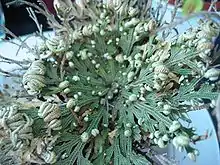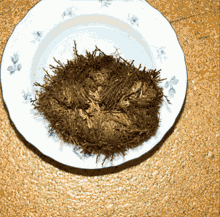Selaginella lepidophylla
Selaginella lepidophylla (syn. Lycopodium lepidophyllum) is a species of desert plant in the spikemoss family (Selaginellaceae). Known as a "resurrection plant", S. lepidophylla is renowned for its ability to survive almost complete desiccation. During dry weather in its native habitat, its stems curl into a tight ball, uncurling only when exposed to moisture.[1]
| Selaginella lepidophylla | |
|---|---|
 | |
| Scientific classification | |
| Kingdom: | Plantae |
| Clade: | Tracheophytes |
| Clade: | Lycophytes |
| Class: | Lycopodiopsida |
| Order: | Selaginellales |
| Family: | Selaginellaceae |
| Genus: | Selaginella |
| Species: | S. lepidophylla |
| Binomial name | |
| Selaginella lepidophylla | |
| Synonyms | |
|
Lycopodium lepidophyllum | |
The outer stems of the plant bend into circular rings after a relatively short period without water. The inner stems instead curl slowly into spirals in response to desiccation, due to the action of the strain gradient along their length.[2] Selaginella lepidophylla reaches a maximum height of 5 cm, and is native to the Chihuahuan Desert.[3]
Names
Common names for this plant include flower of stone,[4] false rose of Jericho, rose of Jericho, resurrection plant, resurrection moss, dinosaur plant, siempre viva, stone flower,[5] and doradilla.
Selaginella lepidophylla is not to be confused with Anastatica. Both species are resurrection plants and form tumbleweeds. They share the common name "rose of Jericho", in reference to the biblical city of Jericho, constantly reborn from its ashes. Similarly, the capacity of S. lepidophylla for revival on rehydration allows it to resurrect and resume growth after long periods of drought.
Description

The striking feature of Selaginella lepidophylla is its adaptation to conditions of prolonged drought in its natural environment. It deploys the physiological strategy of drying up and rolling inwards in the absence of water to form a ball, and can survive for up to several years, and lose up to 95% of its moisture content, without suffering damage.
When ground and air humidity begin to rise again, even a considerable time after it has wilted, the plant "resuscitates". If rehydrated, it continues its life cycle, fully recovering its photosynthesis and growth abilities. When desiccated, its rooted leaves become leathery at the base, appearing dark brown or light to reddish brown.
The dry ball opens a few hours after being placed in contact with water, the parched leaves gradually resuming their green colour. If the roots are not too damaged, the plant may survive in pozzolanic ash. No matter how dried or damaged it becomes, because of the particular biological structure of its leaves the plant retains the ability to imbibe water and unfold itself, even many years after its death.[6]
The plant enters a dormant state in the absence of water, avoiding tissue and cell damage during drying by synthesizing trehalose, a crystallized sugar that acts as a compatible solute. Dissolved salts become concentrated in the plant tissues as water evaporates. The trehalose produced by the plant acts in place of the evaporating water, so preventing the salts from causing damage and protecting against death due to an excess of salinity. S. lepidophylla also uses betaines, substances which have the same function as trehalose.[7]
Once water is restored to the plant tissues, the sugar crystals dissolve and the plant's metabolism, until then paralyzed, reactivates. Leaves that seemed dead turn green, and open.[8]
Lifestyle
Desert conditions
Adapted to the desert environment, Selaginella lepidophylla can survive without water for several years, drying up until it retains only 3% of its mass. The plant can live and reproduce in arid regions for long periods of time. When living conditions become too difficult, the plant's survival mechanism allows it to dry out gradually. Its leaves turn brown and fold in, giving the plant the appearance of a ball. In dormancy, all of its metabolic functions are reduced to a minimum.
Prolonged drought
Where drought persists, the roots may detach, allowing the plant to be carried by the wind. If it encounters moisture, Selaginella lepidophylla may rehydrate and take root in the new location.
Plants that go through the resurrection process are not always able to "rise again". If dehydration has been too rapid, or in the event of irregular alternation of drought and wet conditions, the plant has insufficient time to prepare properly to resist the water stress to which it is subjected. Likewise, the ability to dry up and rehydrate may diminish, in which case, after dozens of cycles of alternate desiccation and regrowth, the plant dies.
As a sporophyte, S. lepidophylla does not produce flowers or seeds but reproduces through spores. Selaginella are neither aquatic plants nor epiphytic plants.[9]
Uses
Selaginella lepidophylla is sold as a novelty item, as bare root stock in its dry state, in which it may be revived with only a little water.[10]
The plant's ability to survive extreme desiccation was noted by Spanish missionaries when they reached the New World, including the area that was to become the United States. The missionaries used S. lepidophylla to demonstrate to potential native converts the concept of being reborn. Because of its properties, the false rose of Jericho was considered a lucky charm, and was passed on in families from generation to generation.
Selaginella lepidophylla has been used as a herbal medicine. An infusion is made by steeping a tablespoon of dried material in hot water, and the resulting tea is used as an antimicrobial to treat colds and sore throat.
In Mexico, S. lepidophylla is sold as a diuretic. Women drink the water in which the plant is soaked to facilitate childbirth. The speed at which the plant blossoms in the water is interpreted as an indication of whether the delivery will be easy or difficult.
The plant is also used in the rites of voodoo and Cuban santería to invoke love and fortune. The plant is said to absorb "negative energy" when worn on the body.[11]
Gallery
 A "revived" plant
A "revived" plant Time lapse of plant uncurling after submersion in water
Time lapse of plant uncurling after submersion in water Dried and curled up
Dried and curled up
References
- Lebkuecher, J. & W. Eckmeier (June 1993). "Physiological Benefits of Stem Curling for Resurrection Plants in the Field". Ecology. 74 (4): 1073–1080. doi:10.2307/1940477. JSTOR 1940477.
- Rafsanjani, A., V. Brulé, T. L. Western and D. Pasini (January 2015). "Hydro-Responsive Curling of the Resurrection Plant Selaginella lepidophylla". Scientific Reports. 5: 8064. arXiv:1703.01052. Bibcode:2015NatSR...5E8064R. doi:10.1038/srep08064. PMC 4306918. PMID 25623361.CS1 maint: multiple names: authors list (link)
- Pampurova, Suzana; Dijck, Patrick Van (July 2014). "The desiccation tolerant secrets of Selaginella lepidophylla: What we have learned so far?". Plant Physiology and Biochemistry. 80: 285–290. doi:10.1016/j.plaphy.2014.04.015. PMID 24813728.
- "Selaginella lepidophylla". Natural Resources Conservation Service PLANTS Database. USDA. Retrieved 9 November 2015.
- "ITIS Standard Report Page: Selaginella lepidophylla". Itis.gov. Retrieved 2012-02-09.
- Mickel, JT & AR Smith. 2004. The Pteridophytes of Mexico. Mem. New York Bot. Gard. 88: 1-1054.
- Davidse, G., M. Sousa Sánchez & S. Knapp. 1995. Psilotaceae to Salviniaceae. 1: i-xxi, 1-470. In G. Davidse, M. Sousa Sanchez & AO Chater (eds.) Fl. Mesoamer .. National Autonomous University of Mexico, Mexico City
- Correll, DS & MC Johnston. 1970. Man. Vasc. Pl. Texas i-xv, 1-1881. The University of Texas at Dallas, Richardson.
- Ahmad Rafsanjani , Veronique Brulé , Tamara L. Western and Damiano Pasini , " Hydro-Responsive Curling of the Resurrection Plant Selaginella lepidophylla " , Scientific Reports , Vol. 5January 27, 2015
- William Francis Ganong (1921). A Textbook of Botany for Colleges. MacMillan Co. p. 604. ISBN 978-1-153-17574-6. page 505-506
- Curtin, L.S.M. and M. Moore. 1997. Healing Herbs of the Upper Rio Grande. Western Edge Press, Santa Fe, New Mexico.
- Schenck, George. 1997. Moss Gardening. Portland: Timber Press
External links
 Media related to Selaginella lepidophylla at Wikimedia Commons
Media related to Selaginella lepidophylla at Wikimedia Commons- Selaginella lepidophylla www.eFloras.org
